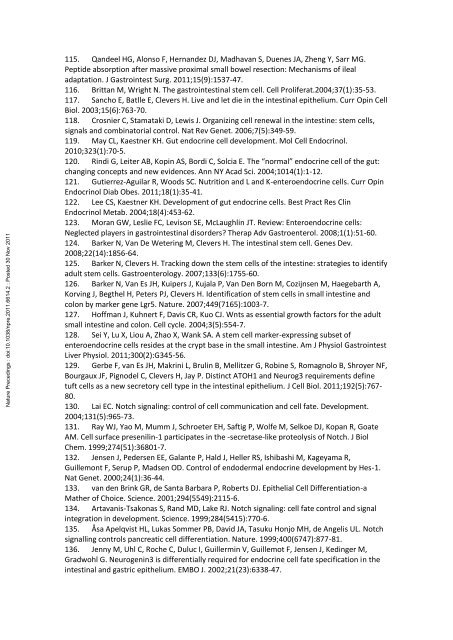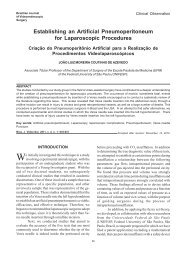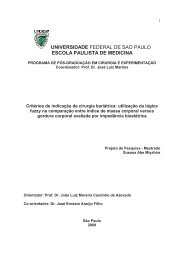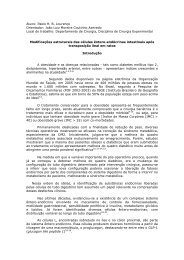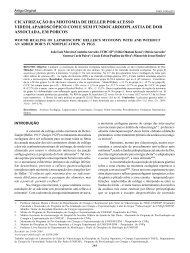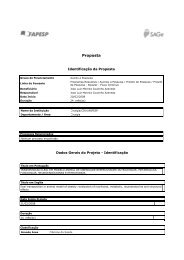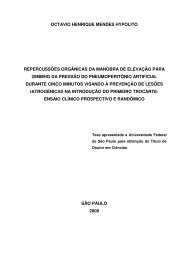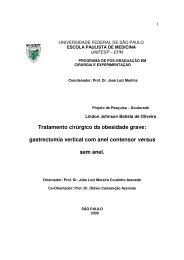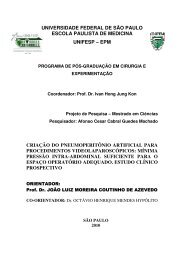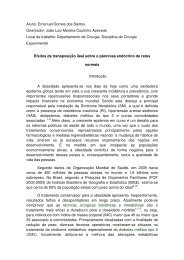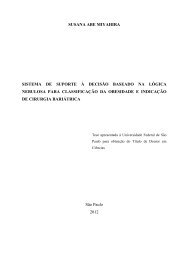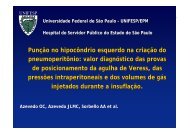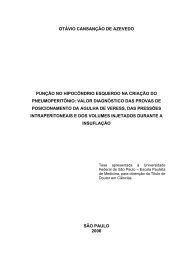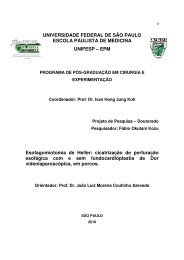Isolated ileal interposition in enteroendocrine L cells differentiation
Isolated ileal interposition in enteroendocrine L cells differentiation
Isolated ileal interposition in enteroendocrine L cells differentiation
Create successful ePaper yourself
Turn your PDF publications into a flip-book with our unique Google optimized e-Paper software.
Nature Preced<strong>in</strong>gs : doi:10.1038/npre.2011.6614.2 : Posted 30 Nov 2011<br />
115. Qandeel HG, Alonso F, Hernandez DJ, Madhavan S, Duenes JA, Zheng Y, Sarr MG.<br />
Peptide absorption after massive proximal small bowel resection: Mechanisms of <strong>ileal</strong><br />
adaptation. J Gastro<strong>in</strong>test Surg. 2011;15(9):1537-47.<br />
116. Brittan M, Wright N. The gastro<strong>in</strong>test<strong>in</strong>al stem cell. Cell Proliferat.2004;37(1):35-53.<br />
117. Sancho E, Batlle E, Clevers H. Live and let die <strong>in</strong> the <strong>in</strong>test<strong>in</strong>al epithelium. Curr Op<strong>in</strong> Cell<br />
Biol. 2003;15(6):763-70.<br />
118. Crosnier C, Stamataki D, Lewis J. Organiz<strong>in</strong>g cell renewal <strong>in</strong> the <strong>in</strong>test<strong>in</strong>e: stem <strong>cells</strong>,<br />
signals and comb<strong>in</strong>atorial control. Nat Rev Genet. 2006;7(5):349-59.<br />
119. May CL, Kaestner KH. Gut endocr<strong>in</strong>e cell development. Mol Cell Endocr<strong>in</strong>ol.<br />
2010;323(1):70-5.<br />
120. R<strong>in</strong>di G, Leiter AB, Kop<strong>in</strong> AS, Bordi C, Solcia E. The “normal” endocr<strong>in</strong>e cell of the gut:<br />
chang<strong>in</strong>g concepts and new evidences. Ann NY Acad Sci. 2004;1014(1):1-12.<br />
121. Gutierrez-Aguilar R, Woods SC. Nutrition and L and K-enteroendocr<strong>in</strong>e <strong>cells</strong>. Curr Op<strong>in</strong><br />
Endocr<strong>in</strong>ol Diab Obes. 2011;18(1):35-41.<br />
122. Lee CS, Kaestner KH. Development of gut endocr<strong>in</strong>e <strong>cells</strong>. Best Pract Res Cl<strong>in</strong><br />
Endocr<strong>in</strong>ol Metab. 2004;18(4):453-62.<br />
123. Moran GW, Leslie FC, Levison SE, McLaughl<strong>in</strong> JT. Review: Enteroendocr<strong>in</strong>e <strong>cells</strong>:<br />
Neglected players <strong>in</strong> gastro<strong>in</strong>test<strong>in</strong>al disorders? Therap Adv Gastroenterol. 2008;1(1):51-60.<br />
124. Barker N, Van De Weter<strong>in</strong>g M, Clevers H. The <strong>in</strong>test<strong>in</strong>al stem cell. Genes Dev.<br />
2008;22(14):1856-64.<br />
125. Barker N, Clevers H. Track<strong>in</strong>g down the stem <strong>cells</strong> of the <strong>in</strong>test<strong>in</strong>e: strategies to identify<br />
adult stem <strong>cells</strong>. Gastroenterology. 2007;133(6):1755-60.<br />
126. Barker N, Van Es JH, Kuipers J, Kujala P, Van Den Born M, Cozijnsen M, Haegebarth A,<br />
Korv<strong>in</strong>g J, Begthel H, Peters PJ, Clevers H. Identification of stem <strong>cells</strong> <strong>in</strong> small <strong>in</strong>test<strong>in</strong>e and<br />
colon by marker gene Lgr5. Nature. 2007;449(7165):1003-7.<br />
127. Hoffman J, Kuhnert F, Davis CR, Kuo CJ. Wnts as essential growth factors for the adult<br />
small <strong>in</strong>test<strong>in</strong>e and colon. Cell cycle. 2004;3(5):554-7.<br />
128. Sei Y, Lu X, Liou A, Zhao X, Wank SA. A stem cell marker-express<strong>in</strong>g subset of<br />
enteroendocr<strong>in</strong>e <strong>cells</strong> resides at the crypt base <strong>in</strong> the small <strong>in</strong>test<strong>in</strong>e. Am J Physiol Gastro<strong>in</strong>test<br />
Liver Physiol. 2011;300(2):G345-56.<br />
129. Gerbe F, van Es JH, Makr<strong>in</strong>i L, Brul<strong>in</strong> B, Mellitzer G, Rob<strong>in</strong>e S, Romagnolo B, Shroyer NF,<br />
Bourgaux JF, Pignodel C, Clevers H, Jay P. Dist<strong>in</strong>ct ATOH1 and Neurog3 requirements def<strong>in</strong>e<br />
tuft <strong>cells</strong> as a new secretory cell type <strong>in</strong> the <strong>in</strong>test<strong>in</strong>al epithelium. J Cell Biol. 2011;192(5):767-<br />
80.<br />
130. Lai EC. Notch signal<strong>in</strong>g: control of cell communication and cell fate. Development.<br />
2004;131(5):965-73.<br />
131. Ray WJ, Yao M, Mumm J, Schroeter EH, Saftig P, Wolfe M, Selkoe DJ, Kopan R, Goate<br />
AM. Cell surface presenil<strong>in</strong>-1 participates <strong>in</strong> the -secretase-like proteolysis of Notch. J Biol<br />
Chem. 1999;274(51):36801-7.<br />
132. Jensen J, Pedersen EE, Galante P, Hald J, Heller RS, Ishibashi M, Kageyama R,<br />
Guillemont F, Serup P, Madsen OD. Control of endodermal endocr<strong>in</strong>e development by Hes-1.<br />
Nat Genet. 2000;24(1):36-44.<br />
133. van den Br<strong>in</strong>k GR, de Santa Barbara P, Roberts DJ. Epithelial Cell Differentiation-a<br />
Mather of Choice. Science. 2001;294(5549):2115-6.<br />
134. Artavanis-Tsakonas S, Rand MD, Lake RJ. Notch signal<strong>in</strong>g: cell fate control and signal<br />
<strong>in</strong>tegration <strong>in</strong> development. Science. 1999;284(5415):770-6.<br />
135. Åsa Apelqvist HL, Lukas Sommer PB, David JA, Tasuku Honjo MH, de Angelis UL. Notch<br />
signall<strong>in</strong>g controls pancreatic cell <strong>differentiation</strong>. Nature. 1999;400(6747):877-81.<br />
136. Jenny M, Uhl C, Roche C, Duluc I, Guillerm<strong>in</strong> V, Guillemot F, Jensen J, Ked<strong>in</strong>ger M,<br />
Gradwohl G. Neurogen<strong>in</strong>3 is differentially required for endocr<strong>in</strong>e cell fate specification <strong>in</strong> the<br />
<strong>in</strong>test<strong>in</strong>al and gastric epithelium. EMBO J. 2002;21(23):6338-47.


